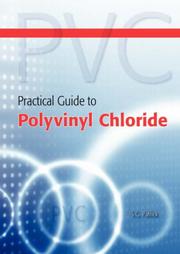| Listing 1 - 10 of 17 | << page >> |
Sort by
|
Multi
ISBN: 9781680157260 9781569905449 1569905444 1680157264 1569905436 9781569905432 Year: 2015 Publisher: Munich ; Cincinnati : Hanser Publishers : Hanser Publications,
Abstract | Keywords | Export | Availability | Bookmark
 Loading...
Loading...Choose an application
- Reference Manager
- EndNote
- RefWorks (Direct export to RefWorks)
PVC differs in its stabilization compared to other commodity plastics. Various metal compounds are suitable for the stabilization of PVC: lead, tin, calcium, magnesium, zinc, rare earths, and also almost-metal-free systems. These differences are described in the introductory part of this book, with their advantages, possibilities, and problems, from the perspective of the chemist but made understandable for salespeople and technicians. Numerous tables and figures are included, providing structures and physico-chemical data. A special section for beginners is dedicated to guiding formulations and test methods. A relatively short section deals with development trends in Europe. Sustainability is a major theme, and it is demonstrated that PVC has a strong potential to develop into a fully sustainable material.
Multi
ISBN: 9781927885642 1927885647 9781927885635 1523134992 9781523134991 1927885639 Year: 2020 Publisher: Toronto, Ontario, Canada : ChemTec Publishing,
Abstract | Keywords | Export | Availability | Bookmark
 Loading...
Loading...Choose an application
- Reference Manager
- EndNote
- RefWorks (Direct export to RefWorks)
Book
ISBN: 9780323994750 032399475X 0323994741 Year: 2024 Publisher: San Diego : Elsevier,
Abstract | Keywords | Export | Availability | Bookmark
 Loading...
Loading...Choose an application
- Reference Manager
- EndNote
- RefWorks (Direct export to RefWorks)
This book provides an in-depth exploration of poly(vinyl chloride) (PVC) and its applications in polymer networks, interpenetrating polymer networks (IPNs), and gels. Edited by Sabu Thomas and H. Akhina, it covers the synthesis, compounding, processing, morphology, and properties of PVC-based materials. Various chapters discuss the manufacturing processes, structural properties, and applications of PVC blends and IPNs, emphasizing their mechanical, thermal, and rheological behaviors. The book also addresses ecological and recycling perspectives, regulatory aspects, and the use of PVC in biomedical applications. It serves as a comprehensive resource for researchers, practitioners, and students in polymer science and engineering.
Polyvinyl chloride. --- Polymer networks. --- Polyvinyl chloride --- Polymer networks
Multi
ISBN: 9781927885628 1927885620 9781927885611 1927885612 1523134984 9781523134984 Year: 2020 Publisher: Toronto, Ontario : ChemTec Publishing,
Abstract | Keywords | Export | Availability | Bookmark
 Loading...
Loading...Choose an application
- Reference Manager
- EndNote
- RefWorks (Direct export to RefWorks)
Polyvinyl chloride --- Stabilizing agents. --- Deterioration.
Periodical
ISSN: 18781381 Year: 2002 Publisher: Oxford : Elsevier Advanced Science,
Abstract | Keywords | Export | Availability | Bookmark
 Loading...
Loading...Choose an application
- Reference Manager
- EndNote
- RefWorks (Direct export to RefWorks)
Polyvinyl chloride --- Polyvinyl chloride. --- Plastique polychlorure de vinyle. --- Polyvinylchloride --- PVC (Chemical) --- Vinyl chloride polymers
Book
ISBN: 168015334X 1895198844 9781927885062 192788506X 9781680153347 9781895198843 9781895198843 Year: 2014 Publisher: Toronto : ChemTec Publishing,
Abstract | Keywords | Export | Availability | Bookmark
 Loading...
Loading...Choose an application
- Reference Manager
- EndNote
- RefWorks (Direct export to RefWorks)
Polyvinyl chloride. --- Polyvinylchloride --- PVC (Chemical) --- Vinyl chloride polymers
Book
ISBN: 1927885647 1927885639 1523134992 9781927885642 9781927885635 9781523134991 Year: 2020 Publisher: Toronto, Ontario, Canada : ChemTec Publishing,
Abstract | Keywords | Export | Availability | Bookmark
 Loading...
Loading...Choose an application
- Reference Manager
- EndNote
- RefWorks (Direct export to RefWorks)
Polyvinyl chloride. --- Polyvinylchloride --- PVC (Chemical) --- Vinyl chloride polymers

ISBN: 1280856491 9786610856497 1847350526 9781847350527 9781280856495 9781859575116 9781847350527 1859575110 6610856494 Year: 2005 Publisher: Shrewsbury, Shropshire, UK : Rapra Technology,
Abstract | Keywords | Export | Availability | Bookmark
 Loading...
Loading...Choose an application
- Reference Manager
- EndNote
- RefWorks (Direct export to RefWorks)
Rapra's Practical Guide to PVC is packed with information for everyone working with PVC. It provides comprehensive background on the resins and additives, their properties and processing characteristics, as well as discussion of product design and development issues. The PVC industry has also started to tackle some of its end-of-life issues.There have been, and still are, issues and perceptions over environmental and health acceptance covering vinyl chloride monomer, dioxins, phthalate plasticisers, and lead (and cadmium) based heat stabilisers and these are discussed in depth in this book.
Polyvinyl chloride. --- Polyvinylchloride --- PVC (Chemical) --- Vinyl chloride polymers
Book
ISBN: 303078455X 3030784541 Year: 2022 Publisher: Cham, Switzerland : Springer,
Abstract | Keywords | Export | Availability | Bookmark
 Loading...
Loading...Choose an application
- Reference Manager
- EndNote
- RefWorks (Direct export to RefWorks)
Polyvinyl chloride. --- Polyvinylchloride --- PVC (Chemical) --- Vinyl chloride polymers
Book
ISBN: 1569908710 1569908729 9781569908723 Year: 2022 Publisher: Munich : Carl Hanser Verlag,
Abstract | Keywords | Export | Availability | Bookmark
 Loading...
Loading...Choose an application
- Reference Manager
- EndNote
- RefWorks (Direct export to RefWorks)
PVC differs in its stabilization compared to other commodity plastics. Various metal compounds are suitable for the stabilization of PVC: lead, tin, calcium, magnesium, zinc, rare earths, and also almost-metal-free systems. These differences are described in the introductory part of this book, with their advantages, possibilities, and problems, from the perspective of the chemist but made understandable for salespeople and technicians.
Polyvinyl chloride --- Additives. --- Deterioration. --- Polyvinylchloride --- PVC (Chemical) --- Vinyl chloride polymers
| Listing 1 - 10 of 17 | << page >> |
Sort by
|

 Search
Search Feedback
Feedback About UniCat
About UniCat  Help
Help News
News